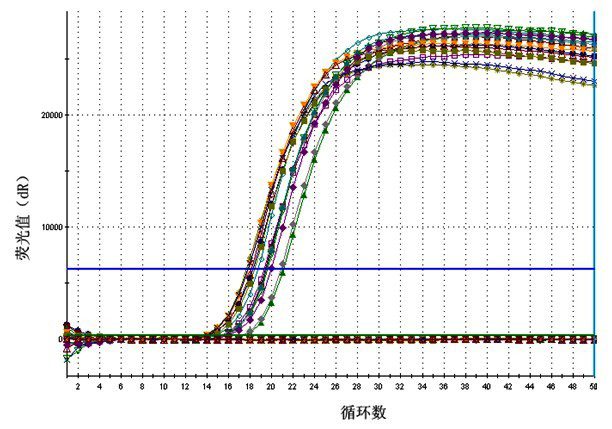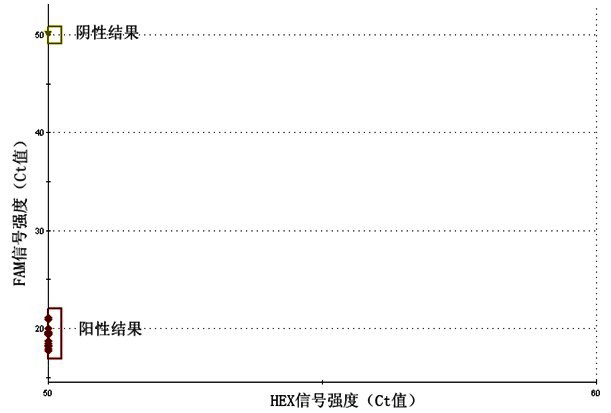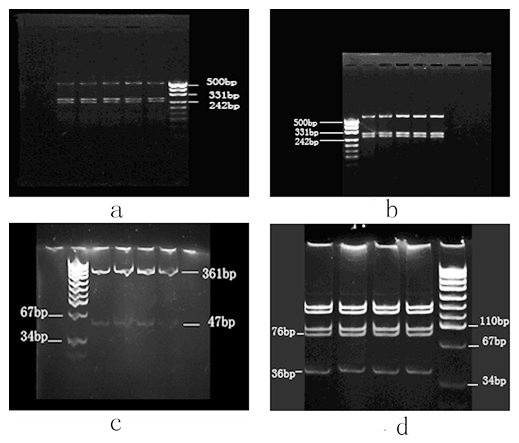Method for detecting haplogroup of chondriogen and application thereof
A mitochondrial gene and haplotype technology, applied in the field of biotechnology
- Summary
- Abstract
- Description
- Claims
- Application Information
AI Technical Summary
Problems solved by technology
Method used
Image
Examples
Embodiment 1
[0024] According to the mtDNA haplotype group typing tree of the East Asian population, 11 characteristic loci in the mtDNA coding region were screened (see Table 1), covering the main mtDNA haplotype groups and their main subtypes of the East Asian population. Point design oligonucleotide probes. Due to the high mutation frequency of mtDNA, it is necessary to avoid common high mutation sites in the probe sequence when designing probes. Then use the primer design software primer premier5.0 to design upstream and downstream primers that include the gene fragments of the desired detection sites. Probes and primers were synthesized by Shanghai Genecore Bioengineering Co., Ltd. The concentrations of the prepared primers and probes were both 20nM / L. PCR reaction solution components: Tris-HCl PH8.5 20mM; KCl 100nM; MgCl 2 3nM; dNTP400nM; Taq enzyme 200U The prepared primer probe and PCRMix solution are stored at -20°C for later use.
[0025] 2. Real-time PCR and data analysis ...
Embodiment 2
[0029] Example 3 Detection of healthy people
[0030] Using the designed oligonucleotide probes related to mtDNA haplogroups in East Asian population, a total of 570 healthy volunteers (Zhejiang Province) were genotyped for mtDNA haplogroups. The distribution is as follows: 101 cases of type F, 101 cases of type B, 9 cases of type R (excluding types F and B), 25 cases of type N9, 43 cases of type A, 140 cases of type D, 19 cases of type G, and type M7 51 cases, 45 cases of M8 type, 17 cases of M9 type, 19 cases of other types. Independent experimenters randomly selected 10% of the samples and used the RFLP method for mtDNA haplotype group typing, and the results were consistent with the probe method. This result suggests that the distribution rates of the main mtDNA haplogroups M, N, and R in the East Asian population are 47.7%, 48.9%, and 37%, respectively, and the distribution rates are the same as the mtDNA haplotypes reported in the literature. The cluster distributions ...
Embodiment 3
[0031] Example 4 Screening of high-risk groups in patients with sepsis
[0032] Using the designed oligonucleotide probes related to mtDNA haplogroups in East Asian population, the mtDNA haplotypes of 181 patients with severe sepsis were typed, and the prognosis and mtDNA haplotypes of these patients were analyzed. relationship is analyzed. The distribution of mtDNA haplotypes in patients was as follows: 31 cases of F type, 35 cases of B type, 66 cases of R type, 8 cases of N9 type, 18 cases of A type, 42 cases of D type, 5 cases of G type, 21 cases of M7 type, There were 13 cases of M8 type, 4 cases of M9 type, and 4 cases of other types. Then 10% of the samples were randomly selected from the patients for mtDNA haplotype group typing by RFLP method, and the results were consistent with the probe method. The results also showed that in the Han population, mtDNA haplotype R is an independent predictor of the prognosis of severe sepsis, and individuals with this mtDNA haploty...
PUM
 Login to View More
Login to View More Abstract
Description
Claims
Application Information
 Login to View More
Login to View More - R&D
- Intellectual Property
- Life Sciences
- Materials
- Tech Scout
- Unparalleled Data Quality
- Higher Quality Content
- 60% Fewer Hallucinations
Browse by: Latest US Patents, China's latest patents, Technical Efficacy Thesaurus, Application Domain, Technology Topic, Popular Technical Reports.
© 2025 PatSnap. All rights reserved.Legal|Privacy policy|Modern Slavery Act Transparency Statement|Sitemap|About US| Contact US: help@patsnap.com



